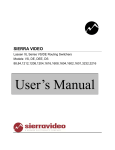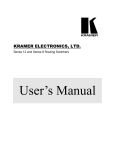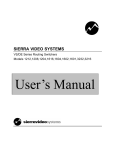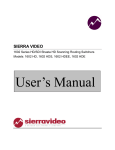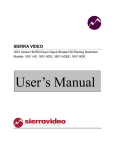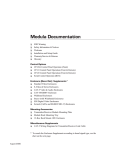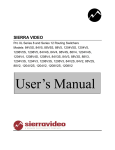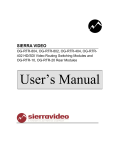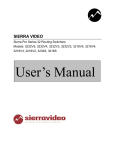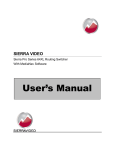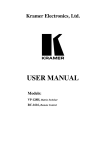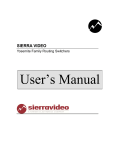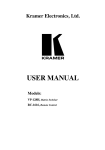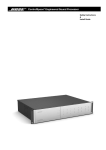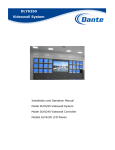Download RS-422 Port Router
Transcript
SIERRA VIDEO RS-422 Port Router 805054 & 805064 User’s Manual SIERRA VIDEO RS-422 ROUTING SWITCHERS User’s Manual Sierra Video P.O. Box 2462 Grass Valley, CA 95945 Tel: (530) 478-1000 Fax: (530) 478-1105 Email: [email protected] Version 4.0 Publication Date: February 2012 The information contained in this manual is subject to change by Sierra Video © Sierra Video SIERRA VIDEO Table of Contents Introduction Before You Begin Warnings & Safety Regulations Warnings Cautions Cautions (continued) Power Supply Cords North American Power Supply Cords International Power Supply Cords EMC Regulatory Notices Delivery Damage Inspection RS-422 Port Router Overview Introduction Model Designations System Components Model 805054 Model 805064 Factors Affecting Quality of Results Installation Introduction Rack Mounting Dimensions Connecting To 422 Devices Connector Pin Outs Port Setup Connecting Peripherals Sync Input AC Power Connections Control Processor Dip Switch Settings 1 1 2 2 2 3 3 3 3 3 3 4 4 4 4 5 5 6 7 7 7 7 8 9 10 10 11 11 11 Operation 13 Communication Protocol 17 Troubleshooting 33 Specifications 35 Warranty 37 Introduction Control via 9-pin Connectors Host Mode Terminal Mode Power Up 13 14 14 14 15 Introduction Generic Protocol Commonly Used Switching Commands Introduction Power and Indicators Control Switching Malfunctions 17 17 31 33 33 34 34 Contents - 1 SIERRA VIDEO 1 Chapter Introduction Before You Begin There are several terms and acronyms that you should become familiar with before reading this manual. They are shown below. Term/Acronym Definition Crosspoint The electronic switch that assigns one of the inputs on the matrix crosspoint modules to an output. Destination The output of a routing switcher connected to a device that receives signals from the output of the switcher. Input Connected to the source that provides the signal to the switcher. Matrix The crosspoint array of the switcher module that selects which input is selected to an output. Output Connects the signal to the destination device. Protocol The command structure used on a serial bus to affect a switch or multiple switches on the routing switcher. Routing Switcher Consists of one or more crosspoint modules that switch together, or sometimes independently, to connect the desired signals through the switcher. Source The signal that is connected to the input of the routing switcher. Serial Port The 9-pin RS232 connector that allows you to control the switcher using a standard personal computer or other external device. Sends control protocol commands in ASCII. 1 SIERRA VIDEO Warnings & Safety Regulations The information in the following section provides important warnings and safety guidelines for both the operator and service personnel. Specific warnings and cautions may be found throughout this manual. Please read and follow the important safety precautions noting especially those instructions relating to risk of fire, electrical shock and injury to persons. Any instructions in this manual that require opening the equipment cover or enclosure are intended for use by qualified service personnel only. To reduce the risk of electrical shock, do not perform any servicing other than what is contained in the operating instructions unless you are qualified. Warnings Heed all warnings on the unit and in the operating instructions. Disconnect AC power before installing any options. Do not use this product in or near water. This product is grounded through the grounding conductor of the power cord. To avoid electrical shock, plug the power cord into a properly wired receptacle before connecting inputs and outputs. Route power cords and other cables so that they are not likely to be damaged, or create a hazard. Dangerous voltages exist at several points in this product. To avoid personal injury, do not touch unsafe connections and components when the power is on. To avoid fire hazard, use only the specified type, correct voltage, and current rating of fuse. Always refer fuse replacement to qualified service personnel. Have qualified personnel perform safety checks after any completed service This is an FCC class A product. In a domestic environment, this product may cause radio interference, in which case the user may be required to take necessary measures. Use the proper AC voltage to supply power to the switcher. When installing equipment, do not attach the power cord to building surfaces. To prevent damage to equipment when replacing fuses, locate and correct trouble that caused the fuse to blow before applying power. Use only the recommended interconnect cables to connect the switcher to other frames. Follow static precautions at all times when handling the equipment. Cautions 2 RS-422 ROUTING SWITCHER Cautions (continued) Leave the side, top, and bottom of the frame clear for air convection cooling and to allow room for cabling. Slot and openings in the frame are provided for ventilation and should not be blocked. Only an authorized Sierra Video technician should service the switchers. Any user who makes changes or modifications to the unit without the expressed approval of the Sierra Video will void the warranty. Power Supply Cords North American Power Supply Cords This equipment is supplied with North American power cords with molded grounded plug (NEMA-15P) at one end and molded grounding connector (IEC 320-C13) at the other end. Conductors are CEE color coded, light blue(neutral), brown(line), and green/yellow(ground). Operation of the equipment at voltages exceeding 130VAC will require power supply cords that comply with NEMA configurations. International Power Supply Cords If shipped outside North America, this equipment is supplied with molded ground connector (IEC 320-C13) at one end and stripped connectors (50/5mm) at the other end. Connections are CEE color coded, light blue (neutral), brown (line), and green/yellow (ground). Other IEC 320-C13 type power cords can be used if they comply with safety regulations of the country in which they are installed. EMC Regulatory Notices Federal Communications Commission (FCC) Part 15 Information: This device complies with Part 15 of the FCC standard rules. Operation is subject to the following conditions: This device may not cause harmful interference This device must accept any interference received including interference that may cause undesirable operations. Delivery Damage Inspection Carefully inspect the frame and exterior components to be sure that there has been no shipping damage. Make sure all modules are seated correctly and have not detached during shipment. Also, make sure the input buffer modules on the rear panel are secure. 3 SIERRA VIDEO RS-422 Port Router Overview Introduction The Sierra Video RS-422 port routing switchers are used with most Sierra Video control systems. The 16 port router is linked to one of these systems where only 16 ports are needed, and controlled as a separate level. The 16 port 1RU router is not designed to be a “stand alone” system. The 64 port frame can also be linked to one of these systems as a separate level, or it can be a “stand alone” router with its own serial control module. These switchers are “port” rather than “XY” designs, unlike the XY system, any connector or “port” can be an Input or Output. This allows the RS-422 level of a large routing switcher to be configured with only as many RS-422 ports as your system needs. You don’t need an RS-422 matrix as large as the video level. A 64 port system can be thought of as a 32x32 XY, a 48x16, or a 56x8, etc. Model Designations The RS-422 Series is a modular design, based on increments of 16 ports. Two frame sizes are available: 1 RU 16 port frame (805054), ideally suited to small systems. 4 RU 64 port frame (805064) for mid-size to large installations. The 1 RU 16 port frame is limited to no less or no more than 16 ports. The 4 RU 64 port frame can be configured as a 16, 32, or 64 port router. It can be expanded in 16 port increments to a maximum of 64 ports by just adding I/O modules. System Components This User's Manual provides installation and operation information for the RS-422 Series Routing Switchers. Front and Rear panel illustrations are provided in the following subsections for each switcher model. Take time to familiarize yourself with the location of your switcher model features. The 4 RU RS-422 64 port system can consist of up to four 16 port I/O modules and a control processor. The 422 switcher may not have a processor module installed. A processor module is not needed if the 422 switcher is to be controlled from another router in a multi-frame configuration. In other words, only 1 processor is needed in a multi-frame configuration. The control processor is based on the same design used in our Tahoe Family routing switchers. The controller has a RS-485 control panel party line bus, an RS-232 personality (terminal) port, an RS-232/RS-422 host port and a parallel control connector for easy integration with other SVS video and audio routing switchers with parallel control output (J1) connectors. The 1 RU RS-422 port system consists of one 16 port I/O module and no control processor. The 1 RU system is only intended for use as a “level” of control, of another routing switcher. 4 RS-422 ROUTING SWITCHER Model 805054 Model 805064 Rear Panel Front Panel (Cover removed) 115/230 VAC switch 16 Port I/O modules Processor module Note: The 4 RU RS-422 64 port system can consist of up to four 16 port I/O modules and a control processor. The 4 RU 64 port frame can be configured as a 16, 32, or 64 port router. It can be expanded in 16 port increments to a maximum of 64 ports by just adding I/O modules. The 422 switcher may not have a processor module installed. A processor module is not needed if the 422 switcher is to be controlled from another router in a multiframe configuration. In other words, only 1 processor is needed in a multi-frame configuration. 5 SIERRA VIDEO Factors Affecting Quality of Results There are many factors affecting the quality of results when signals are transmitted from a source to a destination. Signal cables — Use only the best quality cables to avoid interference and degraded signal quality and elevated noise levels. Sockets and connectors of the sources and destinations — Use only the highest quality, since "zero ohm" connection resistance is the target. Connectors should also match the required impedance (75 ohm in video) to minimize return loss. Amplifying circuitry — must have quality performance when the desired end result is high linearity, low distortion, and low noise. Distance between video sources and destinations — Plays a major role in the final result. For long distances (over 15 meters) between sources and destinations, special measures should be taken to avoid high frequency cable losses. These measures include using higher quality cables and/or adding line cable equalizing amplifiers. Interference from neighboring electrical appliances — These can have an adverse affect on signal quality. Balanced audio lines are less prone to interference, but unbalanced audio should be installed away from any main power lines, electric motors, transmitters, etc. even when the cables are shielded. CAUTION! Only an authorized Sierra Video technician can service the switchers. Any user who makes changes or modifications to the unit without the expressed approval of the manufacturer will void the warranty. Use the proper AC voltage to supply power to the switcher. Use only the recommended interconnect cables to connect the switcher to other frames. 6 SIERRA VIDEO 2 Chapter Installation Introduction Installation procedures are similar for all frames covered under this manual. Exceptions, if any, have been noted in each of the following paragraphs. These switchers are “port” rather than “XY” designs, unlike the XY system, any connector or “port” can be an Input or Output. This allows the RS-422 level of a large routing switcher to be configured with only as many RS-422 ports as your system needs. You usually don’t need an RS-422 matrix as large as the video level. A 64 port system can be thought of as a 32x32 XY, a 48x16, or a 56x8, etc. Rack Mounting Carefully inspect the frame to ensure that there has been no shipping damage. Make sure all shipping material is removed from the router frame. Each of the routing switchers described in this manual can be rack mounted in a standard 19" (RU) EIA rack assembly and includes rack "ears" at the ends of the front of the frames. None of the models require spacing above or below the unit for ventilation. If ample space exists, a 1RU spacing gap is recommended. To rack mount any of the routing switchers, simply place the unit's rack ears against the rack rails of the rack, and insert proper rack screws through each of the holes in the rack ears. Always rack mount the routing switcher prior to plugging the unit into a power receptacle or attaching any cables. Dimensions The 805054 is 1 rack unit high, 19” wide and 8 1/2” deep. The 805064 is 4 rack units high, 19” wide and 8 3/4” deep. 7 SIERRA VIDEO Connecting To 422 Devices Each port can be individually configured using the DIP switches located on the PC board(s). The router comes factory default for automatic pin out selection as described below. If automatic pin out selection is not desired, the connectors may be forced to be either an input or an output port based on the DIP switch as silk screened on the PC board. DIP Switches for Ports 1-8 8 DIP Switches for Ports 9-16 Normal Automatic Pinout- causes the 9 Pin D ports is determined automatically based on the usage of the port. When switched as a destination the port has the equivalent pin out of a VTR (slave). When switched as a source the port has the pin out of an editor (master). This was done to allow a one to one 9 pin D cable to be used for every port connection. Force Destination Pinout- causes the port to be wired as a destination regardless of how the port is switched (i.e. source or destination). Force Source Pinout- causes the port to be wired as a source regardless of how the port is switched. Inverted Automatic Pinout- this setting reverses the TX and RX pinout of the port. RS-422 ROUTING SWITCHER Input (Source) Output (Destination) Controlling Device (Ex; Editor) RS-422 Router Controlled Device (Ex; VTR) Connector Pin Outs The pin out of a port, based on how the DIP switches are set, are listed below: Normal Settings Output (destination) Port Pin 1 Pin 2 Pin 3 Pin 4 Pin 5 Pin 6 Pin 7 Pin 8 Pin 9 Gnd RxTx+ Gnd Gnd Gnd Rx+ TxGnd Input (source) Port Pin 1 Pin 2 Pin 3 Pin 4 Pin 5 Pin 6 Pin 7 Pin 8 Pin 9 Gnd TxRx+ Gnd Gnd Gnd Tx+ RxGnd Inverted Settings Output (destination) Port Pin 1 Pin 2 Pin 3 Pin 4 Pin 5 Pin 6 Pin 7 Pin 8 Pin 9 Gnd TxRx+ Gnd Gnd Gnd Tx+ RxGnd Input (source) Port Pin 1 Pin 2 Pin 3 Pin 4 Pin 5 Pin 6 Pin 7 Pin 8 Pin 9 Gnd RxTx+ Gnd Gnd Gnd Rx+ TxGnd 9 SIERRA VIDEO Port Setup Included in the accessory kit with your order is a test device to help determine the type of configuration (DIP switch settings) each port needs to properly connect your device. The supplied port polarity test device can be used to indicate the transmit lines of any RS-422 device. To use the polarity test device, first disconnect any cabling from the device being tested. Then plug the polarity test device into the 9 pin D RS-422 connector on the device being tested. Either a Green or a Red LED will now be illuminated on the polarity test device. If a Green LED on the polarity test device is illuminated pins 3 and 8 are the transmit pins of the device being tested. If a Red LED on the polarity test device is illuminated pins 2 and 7 are the transmit pins of the device being tested. First, use the polarity test device to determine the transmit pins of the devices to be connected to the port router and record the color of the led that is on for each of these devices. Next send a command to make a route on the port router and use the polarity test device to determine the transmit pins on the connected port. If the color of the led on the port router is the same as the externally connected device, the transmit pins on the port router must be changed for the system to work. To change the transmit pins on the port router, change both dip switches on the port router board for port of interest to the opposite position For instance, if port 1 is incorrect and both of the dip switches are ON, turn both switches to OFF. Connecting Peripherals If the unit is a “stand-alone” or a Master in a system, control panels, sync inputs, serial control, and power are all connected to the rear of the frame. The peripherals area may vary depending on the model type. 1RU (805054) units are always a slave and do not operate as a “stand-alone” router. Some 422 port routing switchers offer redundant power supplies but must be specified prior to order. RS-485 Control Panels J1 Frame RS-232/422 SYNC Interconnect Serial Control 10 RS-422 ROUTING SWITCHER Sync Input There are two BNC connectors labeled "VID. REF. IN". This is a “looping" input for sync referencing. Connect either composite sync or video with sync to either BNC. If desired, use the second BNC to loop the signal to another device. If the loop is not used, terminate the second BNC with 75 ohms. If no sync is available, the routing switcher will switch at a random point rather than during the vertical interval of the reference signal. AC Power Connections The 4RU 64 port routing switchers offer redundant power supplies but must be specified prior to order. The power supply is switchable 115/230 VAC inputs. The voltage selection switch is located behind the front cover on the right side of the frame. The 1RU 16 port routing switcher input voltage must be specified prior to order. These models use a power switch located on the front of the frame. Turn on power to the frame ONLY AFTER all video and control connections have been completed as described. Control Processor Dip Switch Settings If your switcher contains a processor module (64 port 4RU frame only). Your processor has been configured at the factory for the settings you are most likely to need. However, if you want to configure the switcher differently, you can do so by setting the switches located on the processor board (behind the front panel). Dip Switches and their action are given in the table that follows. Terminal port speed (S 1) *9.6K baud 19.2K baud 1 off 1 on Host protocol send X (or X, Y and V) command (S 2) Initially Disabled (U1 enables) *Initially Enabled (U0 disables) Terminal port initial protocol (S 1) *Terminal Host 2 off 2 on Host port speed (S 1) 1.2K baud 4 off 3 off *9.6K baud 4 off 3 on 38.4K baud 4 on 3 off 115.2K baud 4 on 3 on Host port word length (S 1) 7 data bits 5 off *8 data bits 5 on Host port parity type (S 1) *Even 6 off Odd 6 on Host port parity (S 1) *Disabled 7 off Enabled 7 on Host port send Xon/Xoff (S 1) Disabled 8 off *Enabled 8 on 1 off 1 on Panel RS-485 port speed (S 2) 9.6K baud *31.25K baud 2 off 2 on Software download and update (S 2) *Normal operation 3 off Download new software 3 on Host port initial protocol (S 2) 5 off 5 on Host protocol router status commands (S 2) *X command only 6 off X, Y, and V commands 6 on Force crosspoint initialization (S 2) *Restore previous crosspoints 7 off Initialize crosspoints 1-1, 2-2, etc. 7 on Initialize non-volatile memory (S 2) *Normal operation 8 off Clear all settings 8 on Terminal *Host * = Factory settings S2 switch 4 is unused Note: Changing any Dip Switch causes an automatic reset after a few seconds. 11 SIERRA VIDEO 3 Chapter Operation Introduction Those familiar with the SMPTE definition of RS422 machine control are aware that a different pinout configuration is used for devices when they are used as a controller vs a target. On most tape machines capable of RS422 and record, there is a local / remote switch (or similar name) which allows a record machine to control a play machine. Rather than use “null-modem” interconnect cables to sort out the correct pinout in this situation, the SMPTE committee chose to use a pin-to-pin cable, which meant the connector pinout on the machines needed to be different. Not a good decision at the time, but one we must all live with. Because the Sierra Video RS422 routers are port rather input output specific, the 9 pin connectors on the router must change automatically according to how they are used. When a port to port connection is made via the mapping links to a larger AV router, the RS422 router can be set to change I/O pinout as needed to make the selected port pinout correctly correspond to the source and destination links to the AV router. When the RS422 router is used as a standalone, the system decides that when making a port to port connection, whichever port the operator selects first will pinout as a source and the port it connects to will pinout as a destination. To reverse the pinout of the two ports the operator need only select the same two ports in reverse order. These switchers are “port” rather than “XY” designs, unlike the XY system, any connector or “port” can be an Input or Output. This allows the RS-422 level of a large routing switcher to be configured with only as many RS-422 ports as your system needs. You don’t need an RS-422 matrix as large as the video level. A 64 port system can be thought of as a 32x32 XY, a 48x16, or a 56x8, etc. The pin out of each of the 9 Pin D ports is determined automatically based on the usage of the port. An output (destination) port has the equivalent pin out of a VTR (slave), while an input port has the pin out of an editor (master). This was done to allow a one to one 9 pin D cable to be used for every port connection. The router comes factory default for automatic pin out selection as described above. If automatic pin out selection is not desired, the connectors may be forced to be either an input or an output port based on the position of the Dip switches as silk screened on the PC board. The port routers can be controlled by several methods depending on the configuration of the router. If the router is configured as a “level” of control in a multi-frame system, and a frame inter-connection cable is connected to the J-1 connector, the router will be controlled by the frame containing the processor module. 13 SIERRA VIDEO If the router has its own processor module installed, it can be controlled using a remote control panel connected to the RS-485 (3 pin) port. The router can also be controlled using the 9 pin serial connector (see below). Control via 9-pin Connectors The 9-pin connectors allow you to control the routing switcher via an external computer. On some switcher models, the serial port can be changed internally for RS422 configuration (RS232 is factory configuration). Note: The 1RU RS-422 port router is a slave unit only and can not be independently controlled by a PC. The 4 RU (805064) routing switcher model has two ports that are labeled on the back panel as “RS232/422 Control”, Host and Terminal. (Refer also to the illustrations of back panels shown in Chapter 1). The RS-232 serial port is wired; PC 2 RX 3 TX 5 GND RTR 2 TX 8 RX 1 GND Host Mode The 805064 frames, when a processor is installed, have two 9-pin RS232 connectors that allow you to control the switcher using a standard personal computer or other external devices (such as Creston or AMX). The connectors are labeled “Host” and “Term”mode but can be changed to the “Terminal” mode by the following procedure: Connect a terminal to the serial port and send the following command: **HOST0!! The port now uses the terminal protocol. To restore back to the Host port, send the following command: **HOST1!! Terminal Mode The 9-pin connector labeled RS232/422 Control can be used for simple terminal control, (V=T100 emulation capability). The terminal performs the following functions: Serves as an overall system controller Sets up the personality of the entire system (size, level control, change names, mapping, etc.) These setups are stored in non-volatile memory so that a terminal is not required unless it is necessary to change a setup. 14 RS-422 ROUTING SWITCHER Power Up Once all signal and control connections have been made, turn on the power switch. AC to the router is indicated by a illuminated power switch button. If you have power up problems ensure that the AC fuse on the back of the switcher is seated properly. On power up, the controller will restore the routing switcher to the last state it was in before the power was turned off including all configuration settings as well as crosspoint switcher status. 15 SIERRA VIDEO 4 Chapter Communication Protocol Introduction This chapter only applies to the 64 port router and only if a processor (504001) module is installed. The protocol uses the 7-bit ASCII character set, usually sent over an RS232-C or RS422 serial link — 9600 bps is recommended with 8 data bits and no parity. The protocol is compact, with few characters required to cause switch changes to occur. It is also human-readable and thus easy to understand and use. Several different crosspoint switch request commands are defined, so that the one that is most compact for any given switcher and application can be chosen. The protocol is useful with both very small and very large routing switchers. The sizes of the numbers representing inputs, outputs, and levels are not fixed, but can be as large or small as necessary. Special provisions allow numbers to be packed one after another with no intervening delimiter character, in order to make the protocol compact, as long as each number is the largest size necessary for that particular switcher. All input, output, and level numbers begin at number 1, not 0. Generic Protocol Commands are sent to a routing switcher in a group called a command string. A command string can contain zero or more commands, limited only by the size of the receive buffer of the router, whose size depends on the particular router model. A command string consists of a leader string of asterisk characters, zero, or more commands, and a trailer string of exclamation marks. Larger routers require two leader (**) and trailer (!!) characters, while small routers require only one, in order to make the protocol compact for those routers. The remainder of this document gives examples using doubled characters. Note that two leader/trailer characters may be sent to small routers even when only one is required, and they will still work fine. If a leader character (**) is encountered within the command string being processed by a router, the command string up to that point is discarded and a new command string is expected. This ensures that a router will always act on a complete command string sent to it, even if the previous one was never completely received. 17 SIERRA VIDEO When a command string is received, it is not acted upon (but rather, is merely buffered up) until the final trailer character (!) character of the command string is received. At that time, the routing switcher begins to execute the commands within the string. The protocol uses only 7-bit ASCII characters. The 8th bit of received characters is treated as if it is 0. Within the command string, certain ASCII characters may be present and are ignored: any ASCII character whose code is less than the SPACE character (includes all control characters and the SPACE character) and the DEL (ASCII 7F) character. Alphabetic characters within the command string may be in either upper-case or lower-case letters. The router always sends upper case characters, except for character strings such as input, output, and level names, which may have lower case characters in them. When sending commands to the router, SPACE characters are optional, but if used may only appear before and after each individual command and NOT embedded within an individual command. Within command strings sent from the router, a single SPACE character appears before and after each individual command. SPACES may also appear in character strings, such as input, output, and level names. Certain commands (R, Q, L, and G) have character strings that appear as arguments. The first three, “R”, “Q”, and “L”, have character strings only in commands sent from the router, and these character strings are always terminated with a ~ (tilde) character. No special character marks the start of these strings, they simply begin at the appropriate point within the command. The “G” command, on the other hand, uses the ~ (tilde) character to mark both the start and end of a character string argument. Just before the router begins executing a command string, it sends a leader (**) to the host (the same number as are required in commands from the host). As it executes the commands, some of them may generate additional output back to the host. These command response characters are always preceded and followed by a space character, making the response string easily human-readable. After the command string has been executed, the routing switcher returns the string " OK " (with a single space character before and after the word "OK"), followed by the trailer (!!) and a CR (carriage return, ASCII 0D) character, to the host. This indicates that the command has executed successfully. If an error occurs within any command of a command string, the remainder of the command string is ignored and the router returns the string " ERROR ", followed by an optional descriptive string followed by a string of trailer characters and a CR character, to the host. An error can be caused by an unknown command name or bad arguments to a command. The simplest possible command string would be:**!! which consists of the leader and trailer characters but no commands between them. This command string would generate the response: ** OK !!<CR> This can be useful for verifying that the serial link to the router is operational. In routers requiring only one leader/trailer character, the simplest command string would be: *! which would generate the response: * OK !<CR> (To determine whether a particular router uses one or two leader/trailer characters, send it "!!**" and check the response to see which of the above two responses it is. It won’t hurt to always use two even if only one is required.) The simplest error response is one with no optional descriptive string. For example, this command string: ** XXX !! might generate this response from the router: ** ERROR Syntax: No Number:XX !! The descriptive string always ends with a colon and up to three characters from the command string that caused the error. Generally, the error can be assumed to have occurred just before these characters 18 RS-422 ROUTING SWITCHER Leader and Trailer The simplest possible command string would be “**!!” which consists of the leader and trailer characters but no command between them. This command string would generate the response “**OK!!” followed by “CR”. This can be useful for verifying that the serial link to the switcher is operational. The following is the set of commands available for sending to the router, a subset of which may be implemented in any given routing switcher. Syntax Example Description R R Router Reset I I Capabilities Inquiry Q Q Model Name and Software Version Inquiry L L Matrix Size and Level Names Inquiry O O5 Output Status inquiry N N5 Input Status inquiry S S Status inquiry C C Clear matrix K K9999 Set Password to Change Protected Settings M M139 Set Remote Address U {0 1} U0 Update request on/off V out,in,in… V3,1,2,2 Connect levels W lvl,in,in… W1,4,19 Connect outputs X out,in,lvl X12,9,2 Connect crosspoint Y out,in Y1,7 Connect AFV Z in in… Z13,12,8 Connect AFV D numsyncs D300 Delay vertical sync intervals T {A-Z} TB Trigger a Salvo Connect sequence P {A-Z} PBY1,7~ Preset a Salvo connect sequence B B21 Output Lock inquiry or change F F5 Field Delay for crosspoint output 19 SIERRA VIDEO “R”: Router Reset Use this command to force the routing switcher to reset, by sending it the command "RESET". If an administrator password has been set (using the “G ADMIN_PASSWORD” command described later in this document), then the password must be sent in a “K” message prior to sending this command, else this command will generate an error. For example, the command: **RESET!! would initiate a reset (if the password has been entered, if required), and when the router finished the reset operation, something like this would be received, just as if the router had powered up: ** RESET Tahoe Vx.xx (C) 2000~ !!<CR> “I”: Capabilities Inquiry The command "I" requests that command capability information be returned to the host. The information is sent as a string of characters. The first characters are a space followed by "I", the next characters are the letters of the commands that are implemented and available in this router, and the last character is "~" (tilde). Do not count on the characters being in any specific order. Search all characters for a particular one. All routing switchers implement the I, L, S, and X commands. The Q command will eventually be added to all. For example, the command: **I!! might return the following string: ** ILSX~ OK !!<CR> indicating that the router supports the I, L, S, and X commands from the host. “Q”: Model Name and Software Version Inquiry The command "Q" requests that the router model name and software version number string be returned to the host. The information is sent as a string of characters. The first characters are a space followed by "Q", the next characters are the router model name, terminated by a "~" (tilde). Following this are the characters of the software version number string, again terminated by a "~" (tilde). For example, the command: **Q!! might return the following string: ** QSmall~V2.1~ OK !!<CR> indicating that the router model name is "Small" and the software version number is "V2.1". “L”: Matrix Size and Level Names Inquiry The command "L" requests that matrix size (Nout, Nlvl, Nin) and level name information (lvl1, lvl2, etc.) be returned to the host. The information is sent as a string of characters. The first characters are a space followed by "L", some optional values described below, then the number of outputs (Nout), a comma, the number of levels (Nlvl), a comma, the number of inputs (Nin), a comma, and then the level names, each terminated by a "~" (tilde), and the last followed by two tildes. For example, the command: **L!! might return the following string: ** L64,3,32,VIDEO~AudioL~AudioR~~ OK !!<CR> indicating that the router has 64 outputs, 3 levels, and 32 inputs, and the levels are named "VIDEO", "AudioL", and "AudioR". 20 RS-422 ROUTING SWITCHER “O”: Output Status Inquiry The command "O" requests that matrix status information for a single output be returned to the host. The status information is sent as a “Y” command or a “V” command or as a sequence of L “X” commands, where L=number of levels. For example, the command: **O5!! to a 3-level router might have the following three commands as its response: ** X65,23,1 X5,-,2 X5,0,3 !! Note the dash, indicating that on level 2, output 65 is not connected to an input. Also note the 0, indicating that the connection on level 3 is either unknown or that output 65 doesn’t exist or isn’t mapped on level 3. Or, a 3-level router might have the following single command as its response: ** V65,23,-,0 !! which has the same information as the three X commands in the previous example. If the router has only one level, or if all levels are connected the same, the router might instead use the Y command. For example: ** Y65,23 !! “N”: Input Status Inquiry The command "N" requests that matrix status information for a single input be returned to the host. This command is only useful on those router levels that allow an input to be connected to at most one output. The status information is sent as a “Y” command or a sequence of L “X” commands, where L=number of levels that allow an input to be connected to at most one output (each such level generates a single “X” command of status). Thus, a 6-level router with three single-output-per input levels would generate 3 “X” commands of status command output. A router that has all of its levels as single-output-per-input may return a single “Y” command instead of individual “X” commands if all of the levels are connected to the same output. The “X” and “Y” commands are formatted exactly as with the "O" command. For example, the command: **N4!! to a router might have the following three commands as its response: ** X12,4,2 X-,4,3 X0,4,4 !! giving the status of levels 2, 3, and 4 (level 1 presumably not being a single-output-per-input level). Note that on level 3 the ë-ë (dash) indicates that the input is disconnected, and on level 4 the 0 indicates that the connection to the input is either unknown or that input does not exist or is not available on that level. If the router has only one level, or if all levels are connected the same, it might instead use the Y command. For example: ** Y12,4 !! “S”: Status Inquiry Use command S to request that status information be returned to the host. The status information is sent as a string of L x O substrings, where L = number of levels and O = number of outputs. Each level/output combination generates a single substring of status. Thus, a 21-level 16 output router would generate 2x16 = 32 substrings of status command output. The length of each substring depends on the size of the particular switcher involved. Larger switchers use bigger numbers for inputs, outputs, and levels. 21 SIERRA VIDEO The first substring of status is for level 1 output 2, etc.; however, each substring contains the level and output numbers, so the sequence in which the data is sent is not important). The first characters of each substring are a space followed by “X”, then the output number, a comma character, the input number connected to the output (or 0 if no connection exists), another comma, and finally the level number at which the input-output pair is connected. For example, the command: **S!! might have the following two substrings at the beginning of its response: **x01, 12, 1 x02, 02, 1!! This indicates that output 1 is connected to input 12 on level 1, and that output 2 is connected to input 2 on level 1. The number of digits used for each number is generally the maximum number of digits ever required for that particular switcher. Thus, a switcher with between 10 and 99 inputs would use two digits for the input number, and a switcher with less than 10 levels would use one digit for the level number. “C”: Clear Matrix Use command C to request that the switcher matrix be cleared so that all outputs are disconnected from inputs (in switchers where this is possible) or else all outputs at all levels have input 1 as their source. This command can take several seconds to execute (depending on the size of the switcher matrix). In order to help ensure that this command isn’t accidentally executed, it requires four additional characters following the “C” character, to spell out the word “CLEAR” in full. For example, the command: **CLEAR!! would clear the matrix and when finished — the following response would be generated: **OK!!<CR> “K”: Set Password The command "K" is followed by a password, which may be 0 to cancel the previous password, thus causing no password to be specified, or, it may be a value between 1 and 9999 to supply a password, which remains in effect until another password (or password 0) is supplied in another “K” command. The password is stored by the router under the remote address specified using an “M” command, or under the control portís remote address if an “M” command was not specified before the “K” command in the same command string as the “K” command. The password that is set remains in effect until another “K” command is received from the same remote address. It would be used to establish a password for a remote address, to be used for such things as locking and unlocking outputs and modifying the router configuration. When the router receives a protected command (one which requires use of a password) from a remote address, it compares the current password for that remote address with the password required to execute the protected command. Protected commands consist of many of the “G” commands that change router configuration, as well as take and salvo trigger commands when the output to be taken is locked. In the former case, the administrator password is the one that must be sent in the “K” command to permit the router configuration to be changed, while in the latter case the password that was used to lock the output is the one that must be sent in the “K” command to permit the take to occur. Refer to the “B” command and the “G ADMIN_PASSWORD” command (in a separate document) for more information. 22 RS-422 ROUTING SWITCHER For example, the command: ** M197 K1777 !! requests that password 1777 be stored as the current password for remote address 197. The command: ** M197 Y7,9 !! requests that output 7 be connected to input 9, using the password stored for remote address 197 as the output lockout override password. The take will succeed if output 9 is either not locked or is locked with password 1777. Otherwise, the take will fail. “M”: Set Remote Address The command "M" is followed by a remote address value, and it sets the remote address to be used by all remaining commands in the current command string. This command is supported on larger routers. It would be used when a client/server software system on a router control port permits multiple remote users to send commands to the router through that control port. In such a system, the server software that talks to the control port can insert an “M” command at the beginning of each command string it sends to the router on behalf of its clients. The server would assign a different address to each of its clients. The router uses the address to control access to and modification of protected resources. The “M” command will typically work in conjunction with the “K” command, which allows a password to be sent to the router. Some commands, such as those that allow modification of router configuration settings, might require entry of an administrator password before allowing the router configuration to be modified. The “K” command is used to send the password, but the router must be able to record that password in association with a particular remote user. The router would save the password as the one established by the remote address specified in the “M” command. The examples below show how this would work. If the “M” command is not present in a control string received on a serial port, the address assigned to the serial port itself is used as the address for all commands in that command string. The “M” command works on an honor system. There is nothing to keep a remote device from forging a false address. This conforms with the philosophy of providing protection mechanisms that are not designed to be totally hack-proof, but rather, are designed under the assumption that controlling devices will honor the system. A dedicated hacker can always hack into the system if he chooses. Note, however, that the server in a client/server relationship can provide a great deal of added security for the system, forcing the correct “M” command to be sent each time, and filtering out bogus “M” commands received from clients. When the router receives an “M” command in a command string, it echoes the same “M” command in its response. This allows the server connected to the serial port to parse the received response string and determine to which client it should route the response. Normally the server will assign remote addresses to its clients. However, it should always provide a way to send these addresses to the client, because the client needs to know its address in order to know how to interpret some responses. By simply passing each “M” response command received from the router back to the client, the server can let the client know what its address is. For example, the command: ** M139 K9664 !! establishes password 9664 as the password for remote address 139. The response to this command string would be: ** M139 OK !! If remote address 13 later sends the command: ** M139 Y8,27 !! to request that output 8 be connected to input 27, the router would check to see if output 8 has been locked. If so, the router compares the password of remote address 139 (which has previously been set to 96643) to the password that was used to lock output 8. If they match, the connection request succeeds, but if they don’t match, output 8 is left unchanged. 23 SIERRA VIDEO “U”: Update Request on/off The command "U" turns on or off the automatic sending of output change reports. The command letter must be followed by either a number 0, 1, or 2 to specify the new automatic change report state, as follows: 0: Automatic output change reporting is turned off. 1: Automatic output change reporting is turned on. Crosspoint change commands do not immediately report changed status, but instead, the report comes up to a few seconds after the crosspoint change command is received. 2: Automatic output change reporting is turned on, and crosspoint change commands immediately report changed status as part of the response to the command. Output change reports are automatic messages sent to the host whenever an output is crosspoint status (i.e. connected source) is changed. For example, the command: **U1!! turns on automatic output change reporting. When a crosspoint is changed, the following message might be received: ** X5,17,3 !!<CR> indicating that output 5 is now connected to input 17 on level 3. Alternatively, if the router has only a single level or if all levels of the output are connected the same, it might send: ** Y5,17 !!<CR> indicating that output 5 is now connected to input 17. Alternatively, newer routers might use the “V” command instead of “X” commands to report a change: ** V5,17,12,0 !!<CR> indicating that output 5 is now connected to input 17 on level 1, to input 12 on level 2, and does not exist or is not available on level 3. To turn off output change reporting, use the command: **U0!! The difference between an argument value of 1 versus 2 has to do with the response generated by the router when it receives a crosspoint connect command (“V”, “W”, “X”, “Y”, or “Z” command). For example, suppose the router sends the following crosspoint connect commands in a single command sequence: ** Y1,18 Y8,34 !! If U1 is in effect, the response to this command will be: ** OK !!<CR> and then sometime later, perhaps up to several seconds later, the crosspoint change reports will be sent as separate command sequences for each output: ** Y1,18 !!<CR> ** Y8,34 !!<CR> On the other hand, if U2 is in effect, the response to the original crosspoint change command sequence will be: ** Y1,18 Y8,34 OK !!<CR> and no additional crosspoint change reports will be sent because they already HAVE been sent. The U2 mode of operation is generally more convenient because it produces more immediate feedback to the controlling device that is sending a crosspoint change command. The U1 mode of operation is provided for compatibility with older control systems. “V”: Connect Levels The command "V" is used to request that a connection be made. It must be followed by an output number, a comma, and a comma-separated list of input numbers, one for each level, up to the number of levels in the router. Fewer than the number of levels may be specified if desired, and the remaining levels will be left unchanged. For example, the command: 24 RS-422 ROUTING SWITCHER **V12,7,8,9!! says that connections are to be made to output 12: from input 7 on level 1, input 8 on level 2, and input 9 on level 3. An input number of 0 means the output connection is to be left unchanged. An input number of ë-ë (dash) means the output is to be disconnected. If the router does not support disconnected outputs, the output connection will be left unchanged. “W”: Connect Outputs The command "W" is used to request that a connection be made. It must be followed by a level number, a comma, and a comma-separated list of input numbers, one for each output, up to the number of outputs in the router. Fewer than the number of outputs may be specified if desired, and the remaining outputs will be left unchanged. For example, the command: **W1,17,3,9!! says that connections are to be made on level 1: from input 17 to output 1, input 3 to output 2, and input 9 to output 3. If the level number is specified as "0", this means that the connection is to be made on all levels (AFV). For example, the command: **W0,8,3,7!! says that connections are to be made on all levels: from input 8 to output 1, input 3 to output 2, and input 7 to output 3. An input number of 0 means the output connection is to be left unchanged. An input number of ë-ë (dash) means the output is to be disconnected. If the router does not support disconnected outputs, the output connection will be left unchanged. It is an error to request connection of an input or output that doesn’t exist on the specified level, even if the input or output does exist on some other level. However, if the level number is “0”, any input or output may be used as long as it exists on at least one level, and in that case no connection will be made on any level on which the input and output does not exist. If the requested connection has an output or input number that isn’t mapped to a physical connector (on virtual-mapped routers) on one or more levels, those levels are simply not changed. If “U2” is in effect (see “U” command), the response will include one or more V, Y, or X commands to report the new status of the outputs. The response will be the same as if “O” commands were issued for the outputs immediately following the “W” command. No response is generated if this command is being used to define a salvo. “X”: Connect Crosspoint Use command X to request that a connection be made. It must be followed by an output number, a comma, an input number, a comma, and a level number. For example: **X8, 3, 2!! This string says that a connection is to be made between output 8 and input 3 on level 2. If the level number is specified as “0”, this means that the connection is to be made on all levels (AFV). For example, the command: **X8, 3, 0!! This string says that a connection is to be made between output 8 and input 3 on all levels. 25 SIERRA VIDEO “Y”: Connect AFV Use command Y to request that a connection be made. It must be followed by an output number, a comma, and an input number. The connection is made on all levels (AFV). For example, the command: **Y2, 8!! This string says that input 8 is to be connected to output 2 on all levels. “Z”: Connect AFV The command "Z" is used to request that a connection be made. It must be followed by a commaseparated list of input numbers, one for each output, up to the number of outputs in the router. Fewer than the number of outputs may be specified if desired, and the remaining outputs will be left unchanged. The connection is made on all levels (AFV). For example, the command: **Z4,18,7!! says that input 4 is to be connected to output 1 on all levels, input 18 to output 2 on all levels, and input 7 to output 3 on all levels. An input number of 0 means the output connection is to be left unchanged. An input number of ë-ë (dash) means the output is to be disconnected. If the router does not support disconnected outputs, the output connection will be left unchanged. Any input or (implied) output number may be specified as long as it exists on at least one level. No connection will be made on any level on which an input or (implied) output number does not exist. If the requested connection has an output or input number that isn’t mapped to a physical connector (on virtual-mapped routers) on one or more levels, those levels are simply not changed. If “U2” is in effect (see “U” command), the response will include one or more V, Y, or X commands to report the new status of the outputs. The response will be the same as if “O” commands were issued for the outputs immediately following the “Z” command. No response is generated if this command is being used to define a salvo. “D”: Delay vertical sync intervals The command "D" is used to delay before continuing execution of the commands that follow. It must be followed by a number giving the number of vertical sync intervals by which to delay. If the number is 1, the delay will be to the VERY NEXT vertical sync interval. If the number is 0, no delay occurs. The number must be no larger than 255. Note that this command will also delay the time at which the remaining command responses and the trailer character are returned to the host. For example, the command: ** Y1,5 D200 D100 Y1,6 S !! says that input 5 is to be connected to output 1 on all levels, then a delay of 300 (=200+100) sync intervals is to occur, then input 6 is to be connected to output 1 on all levels, then a status response is to be returned. It is generally recommended that the host computer be responsible for timing the initiation of commands, rather than using this command to do the job. The host computer can simply send the appropriate commands at the appropriate times. The "P" and "T" commands described below can aid in ensuring that lengthy connect sequences aren't delayed due to the time it takes to send them to the router. 26 RS-422 ROUTING SWITCHER “T”: Trigger a Salvo The command "T" is used to trigger a previously set up salvo (set using the "P" command above). It must be followed by a register letter from A to Z or a register number from 1 to 256 giving the register to be triggered. For example, the command: ** TB D180 TC !! says to trigger salvo register B (same as 2), delay 180 sync intervals, then trigger salvo register C (same as 3). When the register is triggered, this means that the connect commands stored in it take effect. If a salvo is triggered and it attempts to connect a locked output or port, or a disallowed input/output pair, or a port to itself, the salvo trigger operation is aborted, no crosspoint changes are performed, and an error is reported: “ERROR Salvo Has Locked Xpts”. “P”: Preset a Salvo The command "P" is used to set up a salvo, which is a series of connect commands for later execution with the "T" command. It must be followed by a register letter from A to Z or a register number from 1 to 256 giving the register into which the connect sequence is to be stored, followed by zero or more connect commands (V, W, X, Y, or Z), followed by a "~" (tilde) character. Registers A-Z are the same registers as 1-26. The letter designators are allowed to shorten up the command sequence slightly, so that “T” commands can be sent in compact form if one of the first 26 registers is used. For example, the command: ** PB X2,5,0 Z7 ~ !! says that two connect commands (output 2 to input 5 AFV, and output 1 to input 7 AFV) are to be stored into salvo register B (i.e. register 2). Another example: ** P239 Y5,7 ~ !! says that one connect command (output 5 to input 7 AFV) is to be stored in salvo register 239. Only supported connect commands (those connect commands whose command letters appear in the "I" command response) may follow the register letter up to the tilde character. The connect commands do not take effect until the register is triggered using the "T" command below. The maximum allowed number of connect commands is determined by the particular router. In all cases where this command is implemented, there is guaranteed to be space available to store at least two complete switch matrices AT ONE LEVEL. If more connect commands are received than there is space available to store them, the error response string "FULL ERROR Salvo Space Full" is sent to the host, and only the first part of the salvo is stored. For example: ** FULL ERROR Salvo Space Full !! says that the salvo request filled memory and the salvo could not be completely stored. “B”: Output Lock inquiry or change The command "B" requests that lock information for the specified output be returned to the host, and optionally that the lock status of that output be changed. Whenever the router receives a “B” command, it sends one back. In routers that support the “B” command, the router reports changes to output lock status using the “B” command, not the “G OUTPUT_LOCK” command. When an output is locked, it cannot be routed to a new input unless the password sent using the “K” command matches the password used to lock the output. 27 SIERRA VIDEO In virtual-mapped routers, this command applies lockouts to virtual destinations rather than physical outputs, so the word “output” should be replaced with “destination” in this command description. If the “password” and “lock” arguments are both 0, this is a query for lock status of the specified output. A “B” command is sent to report the lock status. If the “password” argument is not 0, this is a request to change the lock status of the specified output. After changing the lock status, a “B” command is sent to report the new lock status, so a response occurs regardless of which form of the “B” command is sent to the router. When requesting that lock status be changed, if “lock” is 0, this is a request to unlock the output, and if “lock” is 1, this is a request to lock the output. An attempt to lock an output that is already locked, or to unlock an output that is already unlocked, fails, as does an attempt to unlock an output using a password that is different from the password that the output was locked with and is not the administrator password. Any use of a password larger than 9999 also fails. In any of those cases, the output lock status remains unchanged and an error response is generated. The “B” command response will indicate that the output still has the same lock state as before. In the “B” command response that is sent by the router, the “password” argument is the current lock password for the output (1-9999), or is 0 if the output is not locked, and the “lock” argument is 0 if the output is not locked, or 1 if it is locked. When locking an unlocked output, the specified password is recorded by the router as the lock password for that output. When unlocking a locked output, the specified password is compared by the router to the lock password for the output. If they match, or if the specified password is the administrator password, the output is unlocked, else it remains locked. Attempting to lock an already-locked output, or unlock an already-unlocked output, has no effect on the lock state of that output. Whenever a take is done, the router checks to see if the specified output for the take has been locked. If so, the current password of the control port that sent the take request (as set with the “K” command) is compared to the output’s lock password. If they match, the take is allowed, but if not, the take has no effect. The administrator password may NOT be used in lieu of the output’s lock password to do a take, so if a controlling device sends the administrator password in a “K” command, that will not permit the device to reroute locked outputs (but it can use the administrator password to unlock locked outputs using the “B” command). Output lockouts apply on all levels. On virtual-mapped routers, a level may be left out of a lockout by making sure the level is unmapped for the destination being locked. As with all router configuration parameters, the output lockout data is stored in non-volatile storage and thus is retained across router power-ups. When a router is first initialized at the factory, all outputs are set to be unlocked. This command provides the same functionality as the “G OUTPUT_LOCK” command. This command, which was added at router software version V5.06, is preferred over that command. Note that the output lock version number is not present in this command. Since output lock status changes frequently, it is not really useful to cache output lock status for outputs, so the output lock version number is not really useful. For example, to request whether or not output 21 is locked: ** B21,0,0 !! The response might be: ** B21,0,0 OK !! indicating that output 21 is NOT locked. Or, the response might be: ** B21,6741,1 OK !! indicating that output 21 is locked with password 6741. To clear this lockout: ** B21,6741,0 !! To lock output 96 using password 439: ** B96,439,1 !! If successful, the response would be: ** B96,439,1 OK !! 28 RS-422 ROUTING SWITCHER If output 122 becomes locked using password 235, the following change report would be sent by the router: ** B122,235,1 !! “F”: Field Delay The command "F" is used to specify the delay between the time a crosspoint change request is received by the router and the time the crosspoint switch actually occurs. It must be followed by a number giving the number of video fields of delay desired. If the number is smaller than the smallest delay that the router can handle, the smallest delay is used instead. If it is larger than the largest delay the router can handle, the largest delay is used instead. Note that this command does not cause a delay in command processing, as the “D” command does. To understand this command more fully, consider the way that router software will typically handle a crosspoint command. The last character of the command string, the final “!” (exclamation) character, is received somewhere in a particular video field, call it video field 7. The router parses the command string and, for each crosspoint it contains, it puts the crosspoint in a buffer that is marked to be delivered to the crosspoint hardware on a particular video field. Suppose that previously, an “F5” command has been received. Then crosspoint commands whose final “!” command string character was received on video field 7 would be placed in a buffer that is marked to be delivered to the crosspoint hardware at video field 13 (7+5+1=13). To understand the reason for adding 1 in the previous sum, consider an “F0” command: it would ask for output at the very next video field, field 8 in our case. So, it is necessary to add the “F” argument plus 1 to the field number on which the crosspoint command is received to get the field number at which the crosspoint will be output. A typical router will have a minimum delay that is between 1 and 2 fields. Suppose a crosspoint command is received just before a vertical field mark. The software may be able to prepare the crosspoint data and send it to the hardware when that vertical field mark occurs, but the hardware itself typically has a one-field delay in it, so the soonest that such a crosspoint would switch would be one field (plus a little) from when it was received. If the command were received towards the beginning of a field rather than the end of a field, the delay would be closer to two fields. Industry parlance is to call this a one-field delay, because only full fields of delay are counted. The delayfields argument of this command takes into account the hardware delay. So, if a router has a minimum delay, including the hardware delay, of one full field, as described in the previous paragraph, then a delayfields value of 1 causes this minimum delay to be used. A delayfields value of 0 will also cause this minimum delay, because the router uses its minimum if a smaller value is specified. A delayfields value of 2, however, will add one more field to the minimum possible delay. Thus, delayfields specifies the number of full fields of delay between end-ofcrosspoint-command-string-received and crosspoint-switch-occurs. Note that the actual minimum value of delayfields depends on the particular router model. Routers typically have a limit to the number of crosspoint commands they can process in one field. First, there is an inherent delay in sending the command to the router, but beyond that, the router requires time to parse the command and buffer up the crosspoint data, plus it requires time to deliver the buffered data to the hardware when the desired video field arrives. Each individual router has documentation to describe its limitations on how many crosspoints it can process in a given amount of time. Larger values for delayfields give the router more time to process commands. Although the longterm average number of crosspoints that can be processed per unit of time is unchanged, a larger delayfields value can improve router performance during a short burst of many crosspoint commands. For example, suppose a large number of crosspoint commands is sent to the router in a single large command. If delayfields is small, the router typically wonít have time to parse and process all these crosspoint commands and place the data in the crosspoint delivery buffer before the target video field arrives. By making delayfields larger, the user can give the router more time to process the crosspoint commands. 29 SIERRA VIDEO If too many crosspoint commands are received and the router is not able to process them fast enough, it will output the crosspoint connections as soon as it can. Unexpected delays in crosspoint output are a sign that the router is being pushed beyond its limits. The fielddelay value applies to the entire router, not just to the control port on which the “F” command is received. It is therefore recommended that a single value be settled on for the fielddelay value, rather than changing the value constantly depending on needs. Once changed, the router records the value in non-volatile memory and uses it each time it is powered up, so it is only necessary to change it one time. Even though a crosspoint isnít changed until the fielddelay time has elapsed, the router records the new crosspoint state immediately upon receiving the crosspoint change request, so a controlling device may receive a report of a crosspoint change before the change has actually taken effect, and this is more likely to happen the larger fielddelay is. Since routers currently make no guarantees about when they will report a crosspoint change anyway, this behavior is usually of no concern. There is a case where this could cause problems. If the fielddelay value were to be changed while two different devices were changing the same output, it is possible for the router to report the incorrect input value for that output. This would happen if the earlier device that changed the output did so before the fielddelay value was changed, and the later device that changed the output did so after the fielddelay value was reduced but soon enough that its input value would be sent to the crosspoint hardware before that of the earlier device. A bit later, the earlier device’s input value is sent to the crosspoint hardware, but the router has recorded the later device’s input value as being the one in effect. To prevent this scenario, we recommend that an appropriate fielddelay value be chosen, set, and left alone. Here is an example of an “F” command: ** F5 Y1,5 X2,6,3 !! This says that input 5 is to be connected to output 1 on all levels and input 6 is to be connected to output 2 on level 3, after a delay of 5 fields from the beginning of the field that follows receipt of the “!” character. 30 RS-422 ROUTING SWITCHER Commonly Used Switching Commands This section contains the most commonly used switching commands. These commands are explained in detail in the proceeding section and are merely meant as a “short cut” for programmers. “Y” Command- All Levels The “Y” command switches all levels (i.e. video and audio). For example; **Y2,8!! This string says that input 8 is to be connected to output 2 on all levels. “X” Command- Specify Levels Using the “X” command requires that a level is specified. For example; **X8, 3, 2!! This string says that a connection is to be made between output 8 and input 3 on level 2. If a level number of “0” is used, all levels are switched. “V” Command- Connect Levels The “V” command is followed by an output number, a comma, and an input number for each level, up to the number of levels on the router. For example; **V12, 7, 8, 9!! This string says that connections are to be made to output 12 from input 7 on level 1, input 8 on level 2, and input 9 on level 3. 31 SIERRA VIDEO 5 Chapter Troubleshooting Introduction NOTES: If the output signal is disturbed or interrupted by electromagnetic interference, the signal should return and stabilize when the interference ends. If not, turn the power switch off and on again to reset the switcher. If the following recommended actions still do not result in satisfactory operation, please consult your Sierra Video Dealer. Power and Indicators Problem No power Remedy Confirm that the rocker switch is in the “ON” position, and that the power lamp is illuminated. Confirm that power connections are secured at the switcher and at the receptacle. Make sure the receptacle is active, with the proper mains voltage. If there is still no power, check the fuse. Remove power cord from the AC outlet and from the switcher and then remove the fuse holder located above the power connector. Confirm that the fuse is good by looking at the fuse wire connected to the ends of the fuse. If the wire is separated, replace the fuse. 33 SIERRA VIDEO Control Problem Remedy No control of Matrix Switcher from PC software Confirm the correct wiring of the connecting cable. Be sure to use a standard one to one 9 pin serial cable. Confirm that all Dip Switches on the control processor are set properly. See Dip switch settings. Confirm that the baud rate of your computer COM port is set to the same as that of your Matrix Switcher (9600-Baud factory default). Confirm that the proper COM port is selected in the control software. Use a terminal emulator program to send **!! commands and check for **OK!! response. If you do not receive **OK!!, the problem is with the switcher. Re-seat the processor module. Switching Malfunctions Problem Remedy The switcher succeeds in switching a number of sources then fails to switch one. Malfunction in the particular source or cable assembly. NOTE: The most common failure mode in transferring the signal is a break in the connecting wire. Disconnect the source from a channel that is switching successfully and connect the suspect source to it. If the channel continues to switch successfully, then there is something wrong with the Matrix Switcher or the suspect source was not connected properly. If it does not continue to switch successfully, then there is something wrong with the source or cable assembly. The Matrix Switcher turns ON but will not switch at all Check the LEDs on the serial processor board. If they are not counting, the control module is dead. If the control panel is not lit, check the ribbon cable connection between the panel and the processor control module. 34 SIERRA VIDEO 6 Chapter Specifications Connectors & rates I/O connector type Data rate Nominal data rate Mechanical / Electrical One 9-pin female D per "port" 300bs through 250Kbps 8.4Kbps 805054 Power input Power consumption Size 805064 Power input Frequency Response Size 115VAC / 60Hz or 230VAC / 50-60Hz 20VA 1RU (1.75") x 10" deep 115VAC / 60Hz or 230VAC / 50-60Hz 80VA 4RU (7") x 16" deep 35 SIERRA VIDEO SYSTEMS 7 Chapter Warranty A. General Buyer assumes all responsibility for ascertaining the suitability of Sierra Video (hereinafter "SVS") products for Buyer's intended use. No product sold by SVS is designed or manufactured for use in any manner or under any conditions other than those described in SVS's instruction manuals and other printed material for each particular product. If any product is used or applied in a manner or under conditions not specifically authorized by such written materials or if any product is used by unqualified or improperly trained personnel, Buyer agrees that SVS shall have no liability of any kind arising from such use, and Buyer agrees to indemnify and hold SVS harmless from any claims of third parties arising from such use, and Buyer shall provide SVS with counsel of SVS's choice to defend against such claims. B. Limited Warranty 1. This limited warranty applies only to the original purchaser and is non-transferable. This limited warranty begins on the date of purchase and will be in effect for seven (7) years for new equipment and for three (3) years for "Factory Refurbished" equipment. Power Supplies and fans are warranted for three (3) years from the date of purchase for new equipment and two (2) years for “Factory Refurbished” units, from the date of purchase. Buyer must obtain a Return Material Authorization ("RMA") number from SVS prior to returning a product for repair. If, in SVS' sole discretion, the product is found to be defective during the term of this warranty, SVS will at its option: (a) provide free replacement parts, and/or (b) repair the unit at an SVS facility. During the warranty period, SVS will make every reasonable effort to support critical emergencies by supplying no-cost loan equipment while the defective unit is being repaired. SVS will provide replacement parts and/or factory service at no charge. Buyer bears the cost of shipping products returned to SVS under this warranty. SVS will bear the cost of shipping repaired products or replacement parts to the Buyer. This limited warranty shall not apply to any of SVS's goods which have been altered or which have been subjected to misuse, mishandling, improper storage or negligence. The aforementioned provisions do not extend the original warranty period of any goods which have been replaced by SVS. This limited warranty shall not apply to any goods not of SVS's manufacture, Buyer to be entitled only to the warranty set forth in the original manufacturer's limited warranty. 37 SIERRA VIDEO THIS LIMITED WARRANTY IS EXPRESSED IN LIEU OF ALL OTHER WARRANTIES, EXPRESS, IMPLIED OR STATUTORY, INCLUDING WITHOUT LIMITATION THE IMPLIED WARRANTIES OF MERCHANTABILITY AND OF FITNESS FOR A PARTICULAR PURPOSE, AND ALL OTHER OBLIGATIONS OR LIABILITIES ON SVS'S PART. SVS neither assumes nor authorizes any other person to assume for SVS any other liabilities in connection with the sale of products of its own manufacture. 2. SVS's liability hereunder on any claim of any kind, except as set forth herein for any loss, injury to person or property or damage, shall in no case exceed the price allocable to the goods which give rise to such claim. 3. In no event shall SVS be liable for any damages or injuries to person or property if any goods do not meet the above limited warranty, including, without limitation, incidental expenses or consequential or special damages, except as set forth in such limited warranty. The foregoing states the exclusive remedy of Buyer and the exclusive liability of SVS for any breach of the foregoing limited warranty. C. Cancellation Except as provided in paragraph B immediately above, all sales are final, and Buyer may cancel this order or return products only upon written consent of SVS. D. General In the event of a breach of any of the terms hereof, the non-breaching party shall be entitled to recover all of its costs, fees, and expenses, including, without limitation, reasonable attorney's fees, from the breach party incurred as a result of such breach, regardless of whether or not a suit is actually filed to enforce the terms hereof. The provision hereof shall be governed by the laws of the State of California (excluding its choice of law provisions). The headings are for convenience only and do not limit or amplify the terms and provisions hereof. In case any one or more of the provisions set forth herein shall be held to be invalid, illegal, or unenforceable in any respect, the validity, legality, and enforceability of the remaining provisions contained herein shall not in any way be affected or impaired thereby. No waiver, alteration, or modification of any of the provisions hereof shall be binding unless in writing and signed by an authorized Officer of SVS. NOTE: All products returned to SVS for service must have prior approval. Return authorization requests may be obtained from your SVS dealer. 38












































